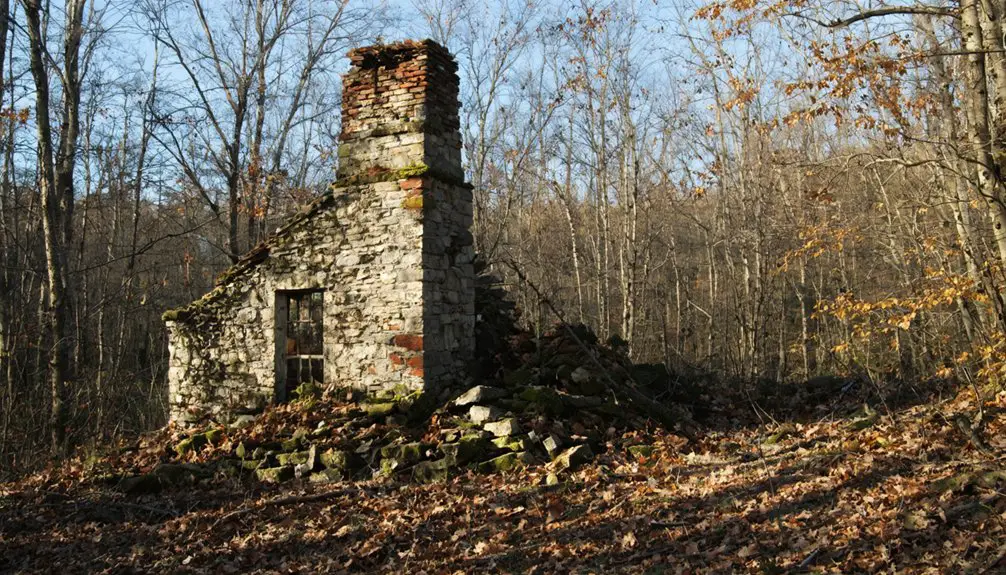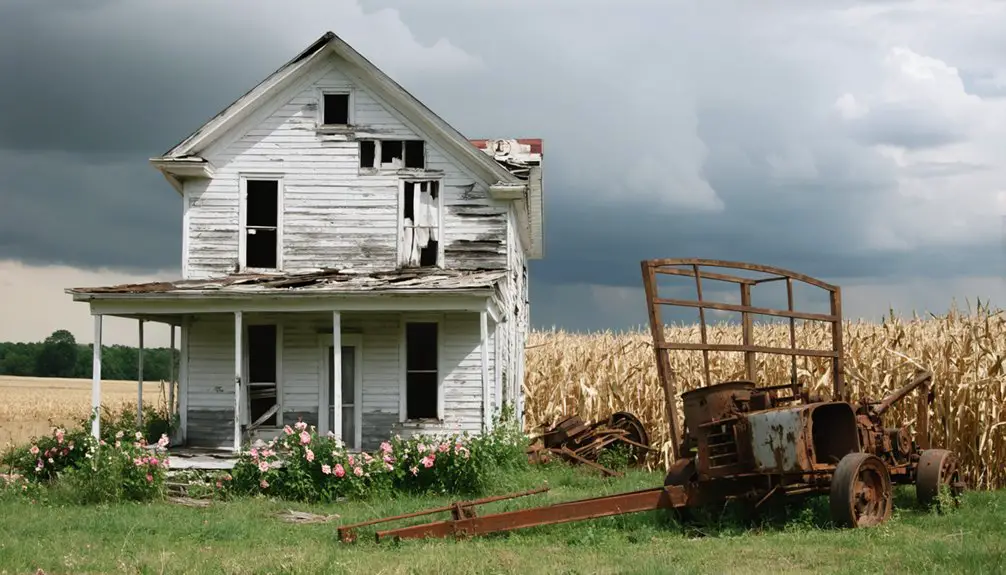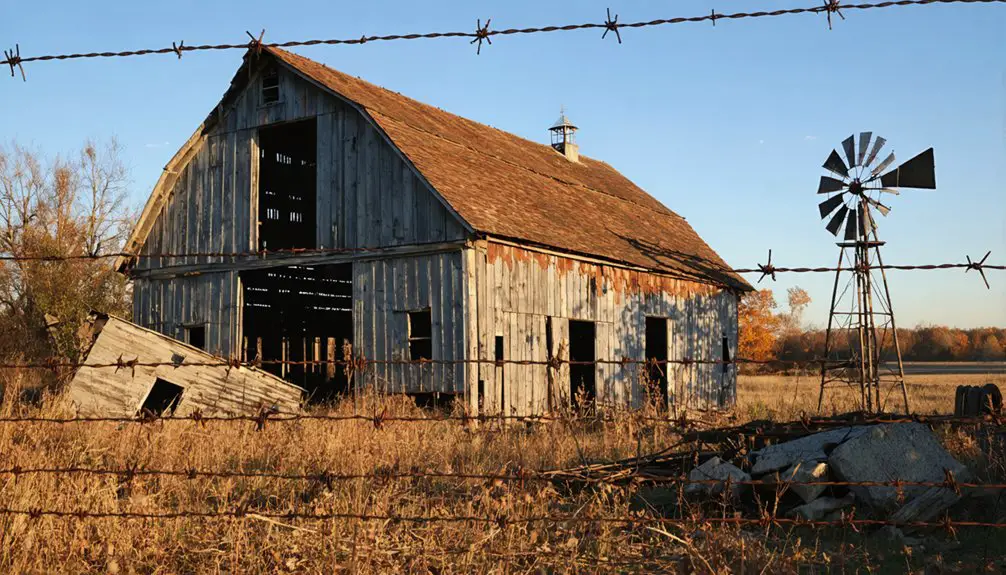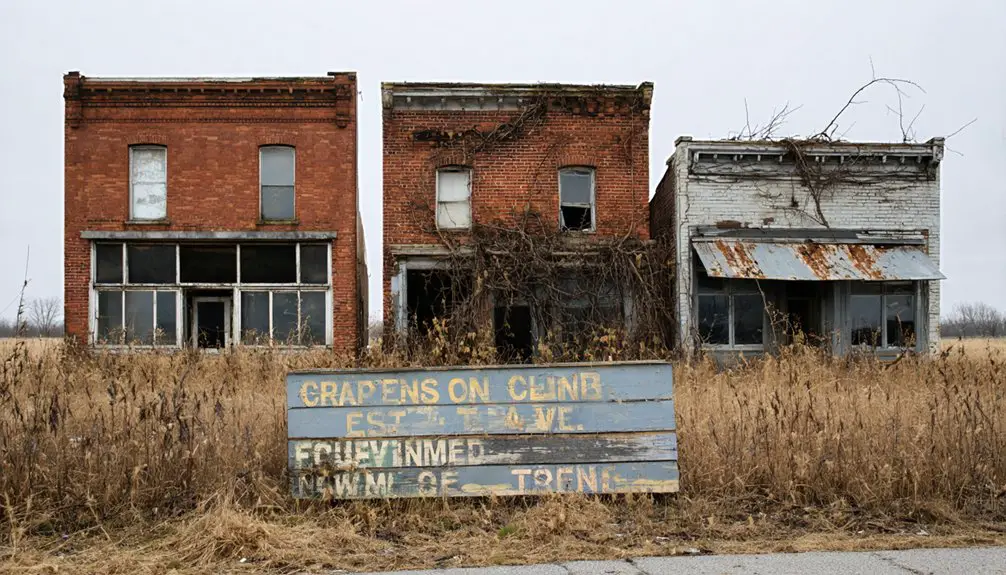You’ll find Ingham’s ghost town ruins along southeastern Ohio’s Moonville Rail-Trail, where this once-bustling coal mining settlement emerged in 1856 alongside the Marietta & Cincinnati Railroad. The town thrived with over a dozen homes, a train depot, and a 1,200-foot coal tunnel until the mines closed in 1909. Today, you can spot scattered brick fragments, metal pieces, and wild daffodils marking former homesteads, while the surrounding forest holds countless untold stories of this vanished community.
Key Takeaways
- Ingham was established in 1856 as a mining settlement along the Marietta & Cincinnati Railroad in southeastern Ohio.
- The town flourished until 1909 when its main coal mine closed, causing residents to leave and the community to decline.
- At its peak around 1900, Ingham contained over a dozen homes, a train depot, general store, and schoolhouse.
- No intact buildings remain today, but artifacts and foundations can be explored via the Moonville Rail-Trail.
- Wild daffodils still bloom seasonally, marking former homestead locations and providing evidence of the ghost town’s past inhabitants.
The Rise of a Mining Railroad Town
When the Marietta & Cincinnati Railroad extended its line through southeastern Ohio in 1856, brothers W. J. and J. M. Ingham seized the opportunity to establish a strategic mining settlement between Moonville and Kings Station.
The railroad expansion transformed this remote area into a bustling industrial hub, with dedicated spur tracks and a depot serving as crucial links to regional markets. Similar to Hope Furnace, the site became an important industrial landmark in the region.
The town’s core was built around impressive mining technology, including a 1,200-foot main coal tunnel in Bear Hollow that connected directly to railroad loading areas.
The coal tipple allowed miners to transfer coal efficiently from mine cars to railroad hoppers.
Multiple mining shafts and drift entries dotted the surrounding hillsides, while the railroad depot, general store, and worker housing created a complete mining community designed for maximum production. The town flourished until mine closure in 1909, which marked the beginning of its decline into abandonment.
Life During Ingham’s Golden Age
At its peak around 1900, Ingham flourished as a close-knit mining community where several families carved out their lives amid the forested hills of southeastern Ohio.
You’d find over a dozen modest homes scattered throughout the town, where miners and railroad workers returned after long days of labor. The community dynamics centered around the mines, railroad depot, and schoolhouse, while a general store supplied essential goods to residents. Moonville Rail Trail Association works to preserve connections between these historic towns.
Daily routines reflected typical rural life of the era, with families using cast iron cookware and mason jars for their domestic needs. Like other places named Ingham, the town developed its own distinct identity and culture.
The town’s residents tended flower gardens – their daffodils still bloom wild today – and relied on the railroad for transportation and commerce.
While isolated, they’d interact with neighboring communities like Moonville for additional social connections.
Notable Buildings and Infrastructure
As you explore Ingham’s key structures, you’ll find the train depot served as the town’s crucial connection point while the general store provided essential supplies to residents.
The local schoolhouse educated children of mining families until the town’s decline in the early 1900s. Like many abandoned settlements in Ohio, this school now stands as one of the few remaining brick foundations today.
The mine operations, which initially drew settlers to establish Ingham, included various support buildings and equipment, though only scattered remnants remain visible today.
Store and Train Depot
The bustling heart of Ingham Station centered around its general store and railroad depot, two crucial structures that served the community around 1900.
The store’s inventory included basic staples and mining supplies, while scattered artifacts like broken pots and cast iron cookware reveal the daily purchasing habits of local residents. You’ll find evidence of the store’s role as both a commercial and social hub through these remnants.
The depot’s services supported both passenger traffic and freight operations along the Marietta-Cincinnati Railroad line.
While handling coal shipments from nearby mines, it facilitated supply deliveries to the store and mail service during the town’s brief post office operation of 1903-1904.
Today, only foundations and scattered railroad parts remain where these significant structures once stood.
Schoolhouse and Mine Operations
Beyond the commercial hub of Ingham Station stood a one-room wooden schoolhouse serving children from over a dozen nearby residences during the town’s peak around 1900.
The schoolhouse’s significance went beyond education – it represented the heart of this close-knit mining community where workers’ families made their home.
Coal mining drove Ingham’s existence, with infrastructure including mine shafts, hoist houses, and tipples integrated with the railroad for efficient transport.
You’ll find evidence of this mining heritage scattered throughout the forest today – iron parts, coal chunks, and structural foundations hint at the town’s industrial past.
While the schoolhouse and mine buildings have largely vanished, careful explorers can still discover brick fragments, metal pieces, and naturalized daffodils growing where these structures once stood.
The Path to Abandonment
You’ll find that Ingham’s path to abandonment began with the closure of its essential coal mines in the early 1900s, which stripped away the town’s economic foundation.
Without mining jobs, families were forced to relocate, leading to a swift population decline that made the local store and schoolhouse unsustainable.
The final blow came decades later when the railroad tracks, which had remained active for freight until the 1980s, were abandoned and later converted into the Moonville Rail-Trail. Similar to nearby small mining communities, the town became heavily dependent on the railway system due to limited road access in the region.
Mining Operations Cease
As coal mining operations began shutting down in Ingham during the early 1900s, this once-thriving Ohio town faced rapid economic decline and eventual abandonment.
You’ll find that smaller mines like Eagle and Jumbo had already closed before 1910, signaling the industry’s diminishing presence in the area.
The economic impacts rippled through the community as alternative fuels like natural gas disrupted the coal market.
The massive Eastern Mine closure in 1937 marked another devastating blow to local employment, as it had previously sustained 400 workers at its peak.
Workforce changes became evident as employment dropped sharply, with remaining mines operating with minimal crews of about seventy-five men per shaft.
The advent of new energy sources, combined with decreased domestic coal demand, made investing in mine improvements unsustainable.
Family-operated mines quietly ceased operations, and supporting industries, including coke ovens that once produced thousands of bushels daily, followed suit.
Railroad Activity Declines
The decline of Ingham’s coal industry dealt a heavy blow to railroad operations that had once sustained the town’s growth.
While railroad expansion in the mid-1800s had transformed Ingham into a bustling mining hub, the closure of mines by 1914 led to a devastating drop in freight traffic.
You’d have seen the Marietta & Cincinnati Railroad, later B&O and CSX, struggle to maintain profitability as both passenger and cargo volumes dwindled. The challenging economic situation mirrored broader issues faced by other railways, as heavy debt burden severely limited their ability to maintain and improve rail infrastructure. The railroad faced similar pressures that had triggered the wage reductions at B&O Railroad in 1877.
Population Exodus Accelerates
Rapid population loss gripped Ingham following the 1909 mine closure, transforming this once-vibrant coal town into a shell of its former self.
You’d have witnessed a dramatic exodus as families sought opportunities elsewhere, following population trends seen across rural Ohio villages.
The economic shifts hit hard – without mining jobs, supporting businesses couldn’t survive. You’d have seen stores close, the school shut down, and the railroad depot fall silent.
The town’s isolation made it particularly vulnerable, with younger residents leaving for urban areas at three times the rate of older citizens.
Like 82% of larger cities across America, urban areas drew residents away from small towns like Ingham with promises of better employment.
Archaeological Discoveries and Remnants
Located within Brown and Waterloo Townships at the intersection of Vinton and Athens counties, Ingham’s archaeological footprint reveals a complex industrial heritage centered on early 20th-century mining and railroad operations.
You’ll find archaeological techniques focus on uncovering remnants of mine shafts, railroad infrastructure, and settlement foundations along the former rail corridor, now known as the Moonville Rail-Trail.
While excavation challenges stem from the site’s extensive weathering and minimal documented discoveries, you can still trace evidence of daily life through possible artifacts like mining tools, household items, and postal service remnants from the William N. Jaynes era (1903-1904).
The ghost town’s location near prehistoric Native American sites, including Hopewell culture mounds, suggests potential for discovering multi-layered occupation evidence beneath the industrial ruins.
Modern-Day Exploration and Legacy

Modern explorers can access Ingham’s remnants through the well-maintained Moonville Rail-Trail, which follows the historic railroad bed and connects to nearby ghost towns like Moonville and King’s Station.
You’ll find the ghost town exploration experience enhanced by recent infrastructure improvements, including new pedestrian bridges and well-documented GPS coordinates (39°18′50″N 82°17′48″W).
While exploring the area within Zaleski State Forest, you can discover scattered artifacts like broken pots, cast iron cookware, railroad parts, and building foundations. Seasonal daffodils mark former homestead locations, offering glimpses into the past.
Scattered remnants of pioneer life peek through the forest floor, with spring flowers marking where families once called home.
Though no intact buildings remain except a nearby church, Ingham’s historical preservation continues through the Moonville Rail Trail Association’s maintenance efforts.
The site stands as a symbol of Appalachian Ohio’s mining heritage, inviting you to explore its railroad and coal mining past.
Frequently Asked Questions
Were There Any Major Accidents or Disasters in Ingham’s History?
You’ll find significant disaster impact through train accidents and mining tragedies near Ingham Station, with accident investigations revealing over 21 deaths at Moonville Tunnel and numerous mining-related fatalities.
What Happened to the Families Who Lived in Ingham?
Like scattered seeds in the wind, you’d find these families dispersed to nearby mining towns, seeking new work and homes, their community legacy living on through artifacts and local tales.
Are There Any Ghost Stories or Supernatural Legends About Ingham?
You won’t find documented haunted locations or spectral sightings specific to Ingham. While nearby places like Moonville and Salem Cemetery have established ghost stories, Ingham itself lacks any verified supernatural legends.
Can Visitors Legally Explore the Ingham Site Today?
Like treading on thin ice, you’ll need to verify legal access before exploring. Stick to the public Moonville Rail-Trail and organized events for guaranteed visitor guidelines-compliant exploration of the site.
What Types of Minerals Were Primarily Mined in Ingham?
You’ll find that coal was the dominant mineral deposit mined in this location, with mining techniques focused on extracting this fuel mineral to support regional industrial development and railroad operations.
References
- https://www.waymarking.com/waymarks/WMP0E_Ingham_Station_Vinton_County_Ohio
- https://en.wikipedia.org/wiki/Ingham
- https://ohioghosttowns.org/top-10-ghost-towns/
- https://www.moonvilletunnel.net
- https://ohioghosttowns.org/vinton-county/
- https://www.geocaching.com/geocache/GCVDWZ
- https://ohioghosttowns.org/county-data-charts/
- https://www.youtube.com/watch?v=rTSZSlxTmbs
- https://www.youtube.com/watch?v=QWTtG6njIDs
- https://en.wikipedia.org/wiki/List_of_ghost_towns_in_Ohio



